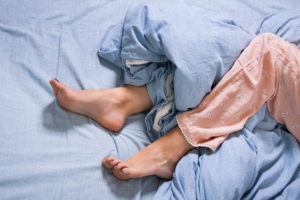
Periodic limb movement disorder (PLMD) and Restless Legs Syndrome (RLS) are two separate issues, but can often occur at the same time. Photo credit: Bigstock
Symptoms and Similarities of Restless Legs Syndrome and Periodic Limb Movement Disorder
You know the feeling. You crawl into bed ready for a good night’s rest, yet you can’t seem to get one. It seems impossible to just be still and settle in and when you do it doesn’t last long. Or maybe you fall right to sleep but no matter what you never feel rested in the morning. These could be signs of an underlying issue. Periodic Limb Movement Disorder and Restless Legs Syndrome are two often overlooked causes of poor sleep.
Periodic limb movement disorder (PLMD) and Restless LegsSyndrome (RLS) are two separate issues, but can often occur at the same time. They both fall under the parasomnia category, as they occur while people are asleep, or attempting to sleep. While episodes do not always fully wake a person, they do cause a sleep disturbance and therefore daytime sleepiness. RLS, unlike PLMD, does also happen during waking hours.
Symptoms for both PLMD and RLS include daytime drowsiness and even insomnia. Because PLMD happens only when people are asleep, they often present as asymptomatic. People can be tired all day, never feeling rested, and be completely unaware that they are experiencing as many as five to fifty sleep disturbances an hour.
Here are a few common characteristics of each disorder.
PLMD
- Occurs only during sleep
- Movements can occur anywhere from 5-50 an hour
- Limb movements are usually a flexed foot or ankle
- Disturbances can be strong enough to wake a patient or make it difficult to stay asleep
RLS
- An urge to move one’s leg or limb that feels uncontrollable.
- Urge is commonly accompanied by sensations of tingling, pulling, itching or tugging that can only be relieved with movement.
- 80% of those with RLS also experience symptoms of PLMD
- Sensation most commonly occurs in legs
- Symptoms are worse at night, but can happen during the day.
- Occurs in both men and women, but more common in men.
Several health risks are associated with ongoing sleep loss or poor sleep. Not to mention the significant impact inadequate sleep can have on your overall quality of life. If you suspect you might suffer from one or both of these sleep-disrupting syndromes, please consider seeking the opinion of a sleep health practitioner. Both RLS and PLMD can be difficult to diagnose without an in depth sleep assessment. There is not a cure for either disorder, but there are treatment options that allow patients to experience quality sleep despite the disorder.
If you suspect you have PLMD or RLS then the best thing to do is to consult a doctor. For most insurance companies, no pre-authorization is required to meet with one of our Board Certified Sleep physicians at Valley Sleep Center. Contact us for more information. 480-830-3900.

